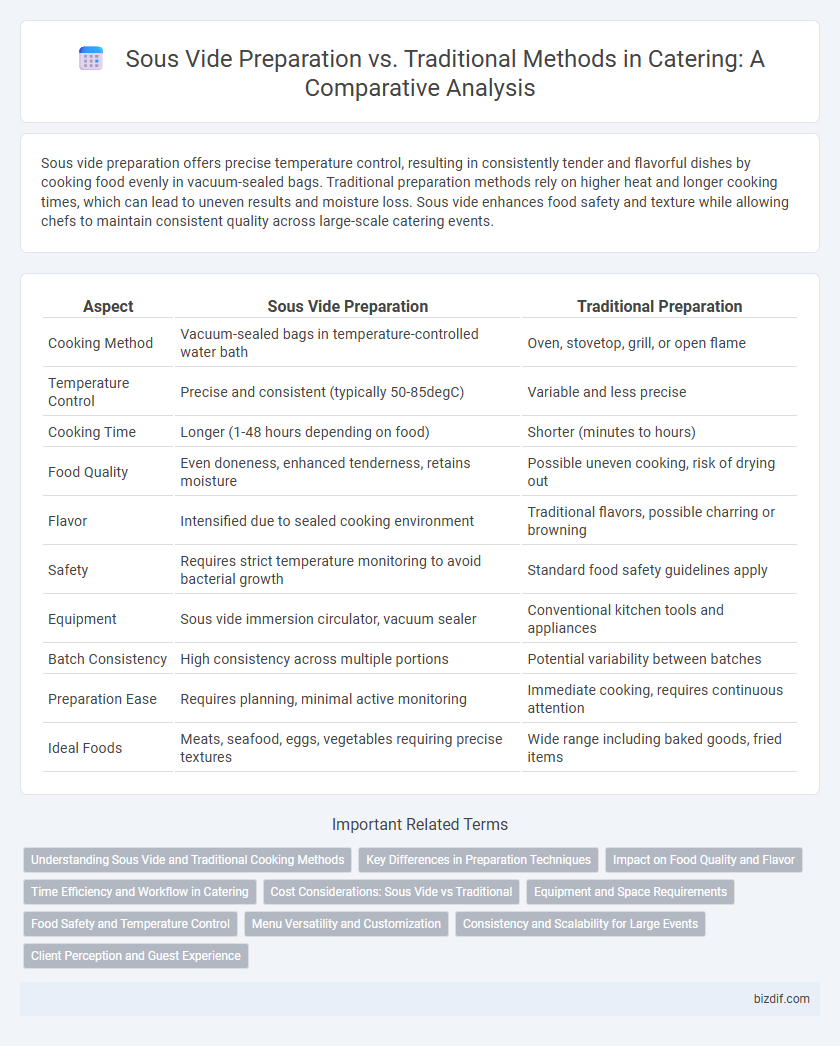Sous vide preparation offers precise temperature control, resulting in consistently tender and flavorful dishes by cooking food evenly in vacuum-sealed bags. Traditional preparation methods rely on higher heat and longer cooking times, which can lead to uneven results and moisture loss. Sous vide enhances food safety and texture while allowing chefs to maintain consistent quality across large-scale catering events.
Table of Comparison
| Aspect | Sous Vide Preparation | Traditional Preparation |
|---|---|---|
| Cooking Method | Vacuum-sealed bags in temperature-controlled water bath | Oven, stovetop, grill, or open flame |
| Temperature Control | Precise and consistent (typically 50-85degC) | Variable and less precise |
| Cooking Time | Longer (1-48 hours depending on food) | Shorter (minutes to hours) |
| Food Quality | Even doneness, enhanced tenderness, retains moisture | Possible uneven cooking, risk of drying out |
| Flavor | Intensified due to sealed cooking environment | Traditional flavors, possible charring or browning |
| Safety | Requires strict temperature monitoring to avoid bacterial growth | Standard food safety guidelines apply |
| Equipment | Sous vide immersion circulator, vacuum sealer | Conventional kitchen tools and appliances |
| Batch Consistency | High consistency across multiple portions | Potential variability between batches |
| Preparation Ease | Requires planning, minimal active monitoring | Immediate cooking, requires continuous attention |
| Ideal Foods | Meats, seafood, eggs, vegetables requiring precise textures | Wide range including baked goods, fried items |
Understanding Sous Vide and Traditional Cooking Methods
Sous vide preparation uses precise temperature control by vacuum-sealing food and cooking it in a water bath, ensuring consistent texture and enhanced flavor retention. Traditional cooking methods like grilling or roasting rely on direct heat, which can lead to uneven cooking and moisture loss. Understanding the differences between these techniques helps caterers select the best approach for optimal food quality and efficiency.
Key Differences in Preparation Techniques
Sous vide preparation involves vacuum-sealing food and cooking it at precise, consistent low temperatures in a water bath, ensuring even doneness and enhanced moisture retention. Traditional preparation methods typically use direct dry-heat or moist-heat techniques, such as grilling, roasting, or boiling, which can result in uneven cooking and greater moisture loss. The key difference lies in sous vide's ability to control temperature precisely over extended periods, producing tender and flavorful results with minimal risk of overcooking.
Impact on Food Quality and Flavor
Sous vide preparation preserves food quality by cooking at precise, consistent temperatures, ensuring evenly cooked dishes with enhanced moisture retention and intensified natural flavors. Traditional methods often involve higher heat and longer cooking times, which can lead to nutrient loss, uneven textures, and diminished flavor complexity. The controlled environment of sous vide minimizes overcooking and oxidation, resulting in superior taste and texture compared to conventional techniques.
Time Efficiency and Workflow in Catering
Sous vide preparation offers precise temperature control allowing consistent quality while reducing hands-on time, making it highly efficient for large-scale catering operations. Traditional cooking methods often require constant monitoring and batch-wise processing, which can slow down workflow and increase labor costs. Integrating sous vide into catering workflows streamlines meal preparation, optimizes kitchen staff allocation, and enhances overall time efficiency.
Cost Considerations: Sous Vide vs Traditional
Sous vide preparation reduces labor costs by requiring less active monitoring and consistent results, minimizing waste due to precise temperature control. Traditional cooking methods often involve higher energy consumption and increased ingredient loss from overcooking, driving up overall expenses. Equipment investment in sous vide devices is offset by long-term savings through improved efficiency and portion control.
Equipment and Space Requirements
Sous vide preparation requires specialized equipment such as immersion circulators and vacuum sealers, which can be compact but necessitate dedicated counter space and power outlets. Traditional cooking methods rely on standard kitchen appliances like ovens, stovetops, and pots, often demanding larger space for multiple burners and ventilation. Catering operations must consider that sous vide setups streamline precise temperature control with minimal space, whereas traditional methods may require more extensive kitchen layouts to accommodate varied cooking techniques.
Food Safety and Temperature Control
Sous vide preparation ensures precise temperature control by cooking food in vacuum-sealed bags at consistent low temperatures, significantly reducing the risk of bacterial growth compared to traditional methods. This technique maintains food safety by eliminating temperature fluctuations common in conventional cooking, which can allow pathogens to thrive. Traditional preparation often exposes food to uneven heat, increasing the chance of undercooking and contamination, making sous vide a safer choice for catering professionals focused on optimal hygiene and consistency.
Menu Versatility and Customization
Sous vide preparation enhances menu versatility by allowing precise control over cooking temperatures, resulting in consistent textures and flavors tailored to diverse dietary preferences. Traditional preparation methods often limit customization due to temperature variability and risk of overcooking, affecting the quality across different dishes. Catering services utilizing sous vide can efficiently accommodate specialized menus, including gluten-free, vegan, and allergen-free options, ensuring high-quality outcomes for varied client needs.
Consistency and Scalability for Large Events
Sous vide preparation delivers unparalleled consistency by cooking food at precise, controlled temperatures, ensuring uniform doneness across thousands of portions ideal for large events. Unlike traditional methods that often result in uneven cooking due to variable heat exposure, sous vide's vacuum-sealed bags retain moisture and flavor, enhancing quality and reliability. Scalability is streamlined through batch cooking and easy reheating without compromising texture or taste, making sous vide the preferred choice for catering operations managing high volumes efficiently.
Client Perception and Guest Experience
Sous vide preparation in catering enhances client perception by ensuring consistently tender and flavorful dishes, elevating guest experience through precise temperature control and uniform cooking. Traditional preparation methods may offer familiar textures but often lack the precision that guarantees consistent quality across large events. Clients value the modernity and reliability of sous vide, which translates into positive reviews and repeat bookings due to its impact on taste and presentation.
Sous vide preparation vs Traditional preparation Infographic

 bizdif.com
bizdif.com